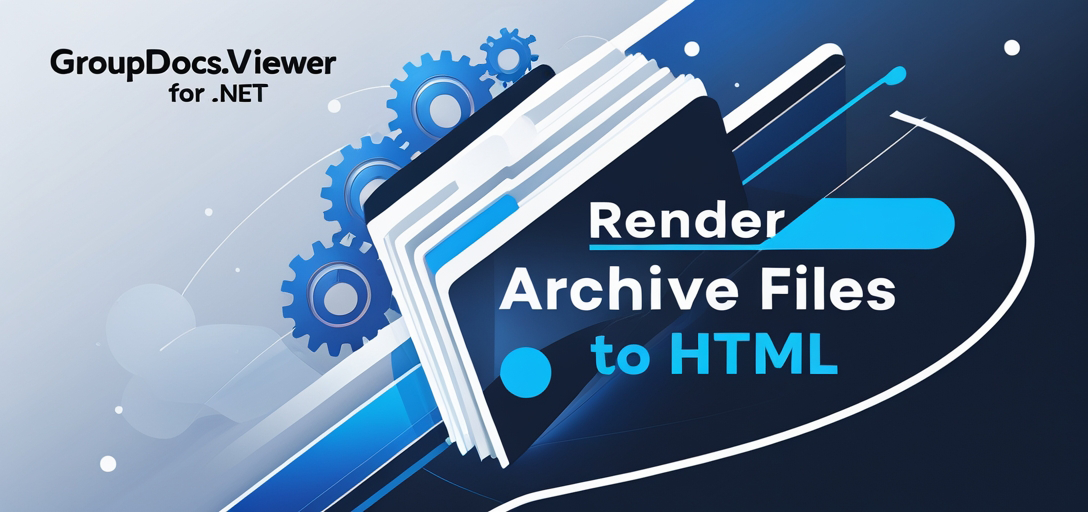How to Render Archive Files to HTML Using GroupDocs.Viewer .NET: A Step-by-Step Guide
Introduction
Struggling with presenting archive files like RAR or ZIP on a web page? Converting these complex file formats into user-friendly HTML documents is crucial for seamless content delivery. With GroupDocs.Viewer for .NET, this task becomes straightforward and efficient.

In this tutorial, we’ll guide you through converting archive files into both single-page and multi-page HTML formats using the powerful GroupDocs.Viewer library. By the end of this guide, you will:
- Set up your environment with GroupDocs.Viewer for .NET
- Render archives as single or multiple page HTML documents
- Optimize performance and troubleshoot common issues
Let’s dive into transforming archive files with ease!
Prerequisites
Before we begin, ensure you have the following in place:
- Required Libraries: You need GroupDocs.Viewer for .NET version 25.3.0.
- Environment Setup: This guide assumes you are working within a .NET environment that supports C#.
- Knowledge Prerequisites: Familiarity with basic C# programming and understanding of HTML is beneficial.
Setting Up GroupDocs.Viewer for .NET
To use GroupDocs.Viewer, install it via NuGet Package Manager or the .NET CLI:
NuGet Package Manager Console
Install-Package GroupDocs.Viewer -Version 25.3.0
.NET CLI
dotnet add package GroupDocs.Viewer --version 25.3.0
License Acquisition
To get started, you can opt for a free trial or purchase a license. For temporary use, apply for a temporary license to unlock full features:
- Free Trial: Download Free Trial
- Temporary License: Get Temporary License
Basic Initialization
Here’s how you can initialize GroupDocs.Viewer in your C# project:
using GroupDocs.Viewer;
// Initialize the Viewer object with the path to your document.
using (Viewer viewer = new Viewer("path/to/document"))
{
// Your code here
}
Implementation Guide
Rendering Archive Files to Single Page HTML
This feature allows you to render an entire archive into a single, easily navigable HTML page.
Overview
Rendering to a single-page format is ideal for small archives where compactness and simplicity are key. It ensures all content is accessible on one webpage.
Implementation Steps
1. Set Up Your Environment Ensure your output directory exists:
string outputDirectory = "YOUR_OUTPUT_DIRECTORY";
string pageFilePathFormat = Path.Combine(outputDirectory, "RAR_result.html");
2. Create a Viewer Object Initialize the viewer with the path to your archive file:
using (Viewer viewer = new Viewer("YOUR_DOCUMENT_DIRECTORY/SAMPLE_RAR_WITH_FOLDERS"))
{
// Code for rendering will be added here.
}
3. Configure HTML View Options Set up options to embed resources and render as a single page:
HtmlViewOptions options = HtmlViewOptions.ForEmbeddedResources(pageFilePathFormat);
options.RenderToSinglePage = true; // This ensures all content is on one page.
viewer.View(options); // Render the archive file.
Rendering Archive Files to Multiple Pages HTML
For larger archives, rendering into multiple pages helps manage content effectively.
Overview
This approach splits the archive’s contents across several HTML documents, allowing for better organization and navigation of large datasets.
Implementation Steps
1. Set Up Page File Path Define a format for output files:
string pageFilePathFormat = Path.Combine(outputDirectory, "RAR_result_page_{0}.html");
2. Create a Viewer Object As before, initialize the viewer with your archive file:
using (Viewer viewer = new Viewer("YOUR_DOCUMENT_DIRECTORY/SAMPLE_RAR_WITH_FOLDERS"))
{
// Code for rendering will be added here.
}
3. Configure HTML View Options Set options to split content across multiple pages:
HtmlViewOptions options = HtmlViewOptions.ForEmbeddedResources(pageFilePathFormat);
options.ArchiveOptions.ItemsPerPage = 10; // Adjust the number of items per page as needed.
viewer.View(options); // Render the archive file into multiple pages.
Practical Applications
Content Management Systems: Easily display archived content within CMS platforms like WordPress or Drupal.
Document Libraries: Integrate with systems such as SharePoint for enhanced document accessibility.
E-commerce Platforms: Showcase product catalogs stored in archive formats directly on web pages.
Educational Portals: Distribute course materials and resources efficiently to students.
Internal Corporate Dashboards: Render company reports or data archives for internal use.
Performance Considerations
To ensure smooth performance when rendering large files:
- Optimize HTML Output: Minimize embedded resource sizes.
- Manage Memory Usage: Dispose of the
Viewerobject properly to free resources. - Use Caching: Cache rendered pages if they are accessed frequently.
Conclusion
In this guide, we explored how to use GroupDocs.Viewer for .NET to convert archive files into both single-page and multi-page HTML formats. By following these steps, you can efficiently present archived data on the web with minimal effort.
Next Steps
Explore more features of GroupDocs.Viewer by diving into its extensive documentation or trying out different file formats. Consider integrating your solution with existing .NET applications for enhanced functionality. Ready to take your archive rendering skills to the next level? Start implementing today!
FAQ Section
What is GroupDocs.Viewer for .NET used for?
- It’s a library that converts documents into HTML, image, or PDF formats in .NET environments.
How do I handle large archive files with GroupDocs.Viewer?
- Consider rendering them as multiple pages and optimize your resource management strategies.
Can GroupDocs.Viewer render non-archive file formats?
- Yes, it supports a wide range of document types beyond archives.
Is there support for customizing the rendered HTML output?
- Absolutely, you can tailor the appearance by adjusting view options and styling embedded resources.
What are common troubleshooting steps if rendering fails?
- Check file paths, ensure all dependencies are installed, and verify that your GroupDocs.Viewer license is active.